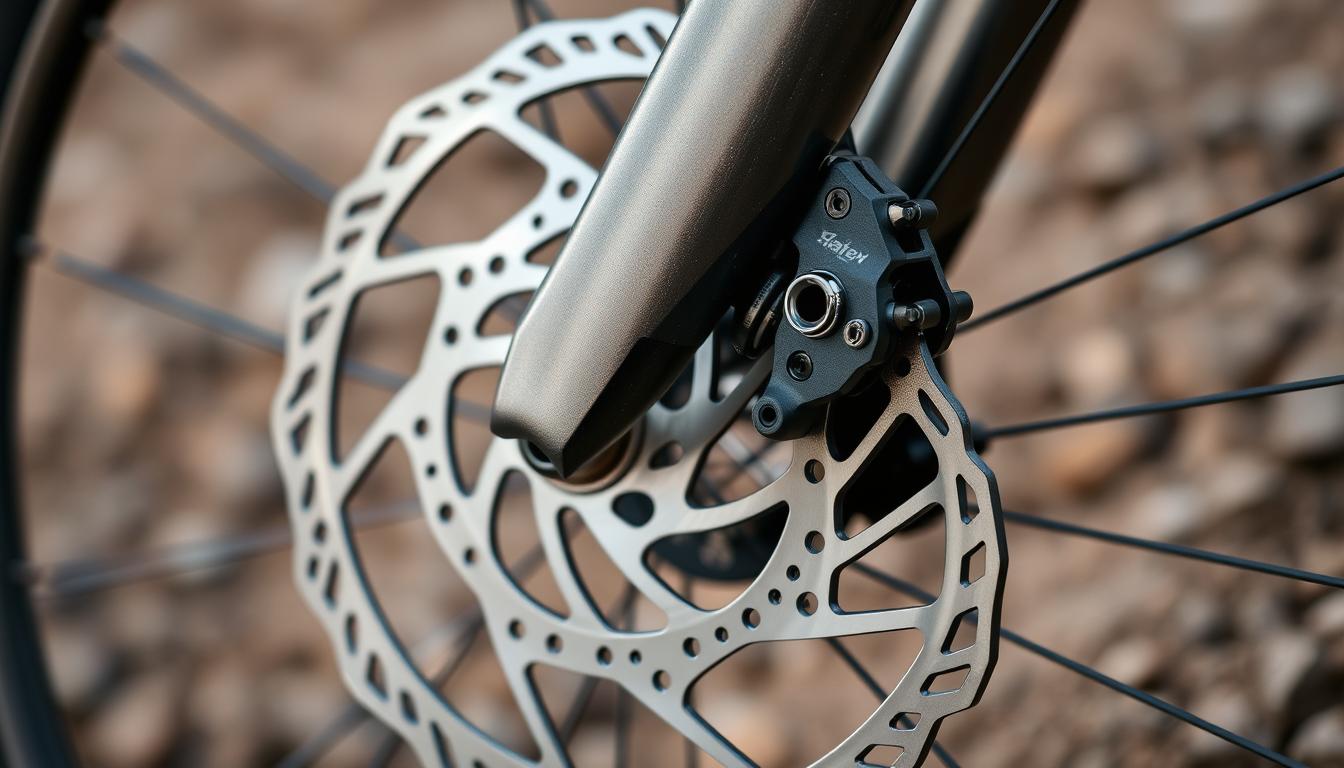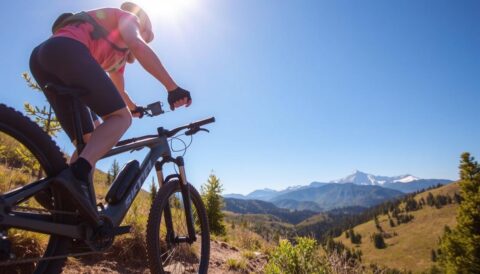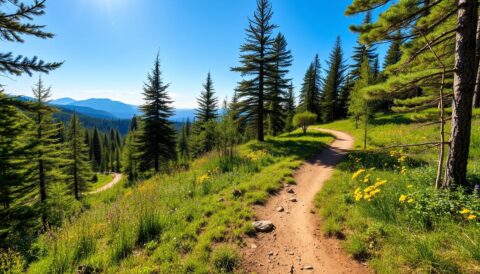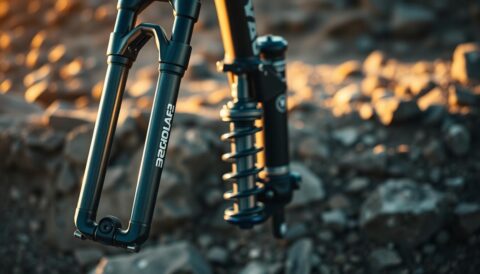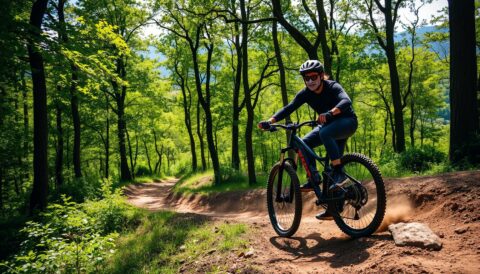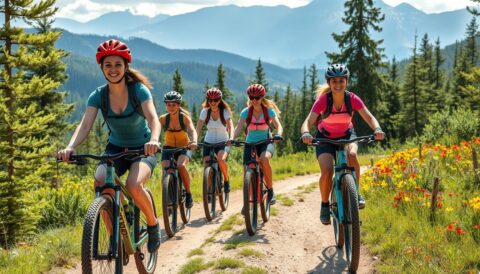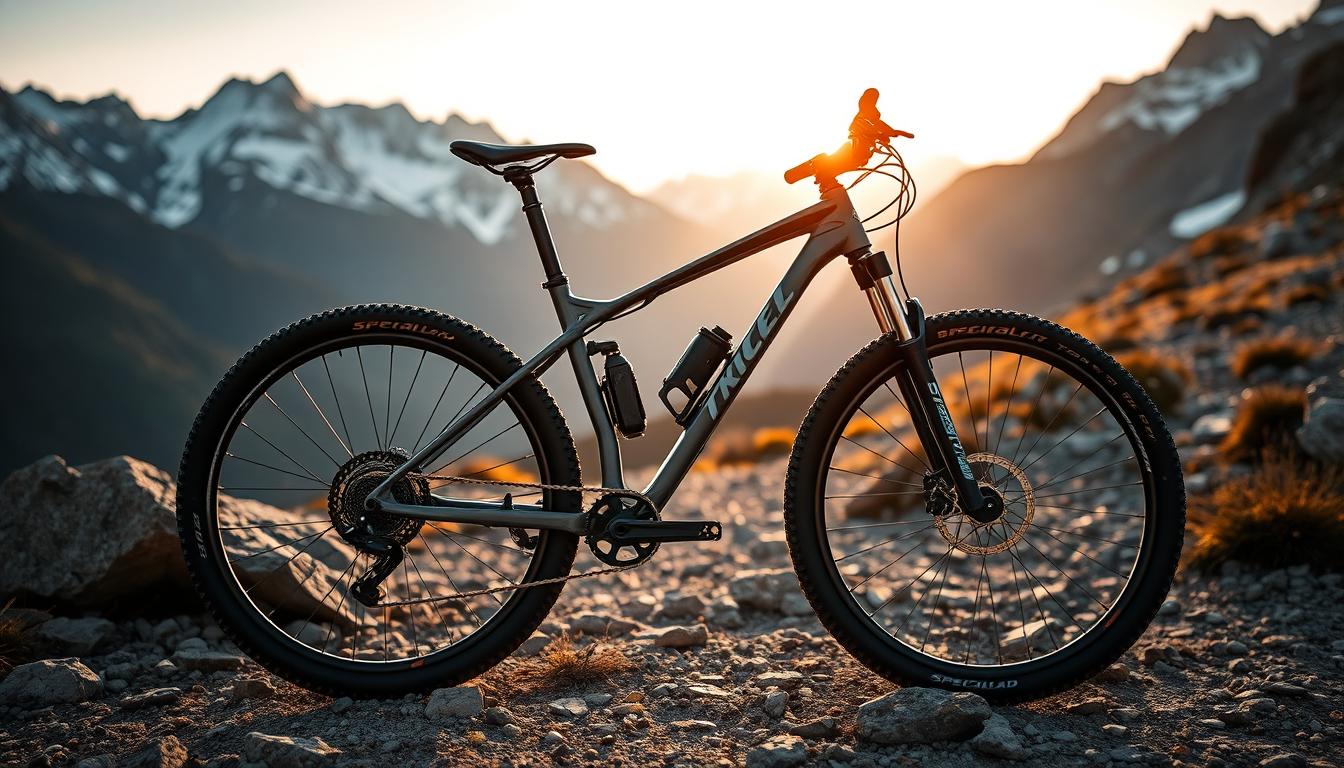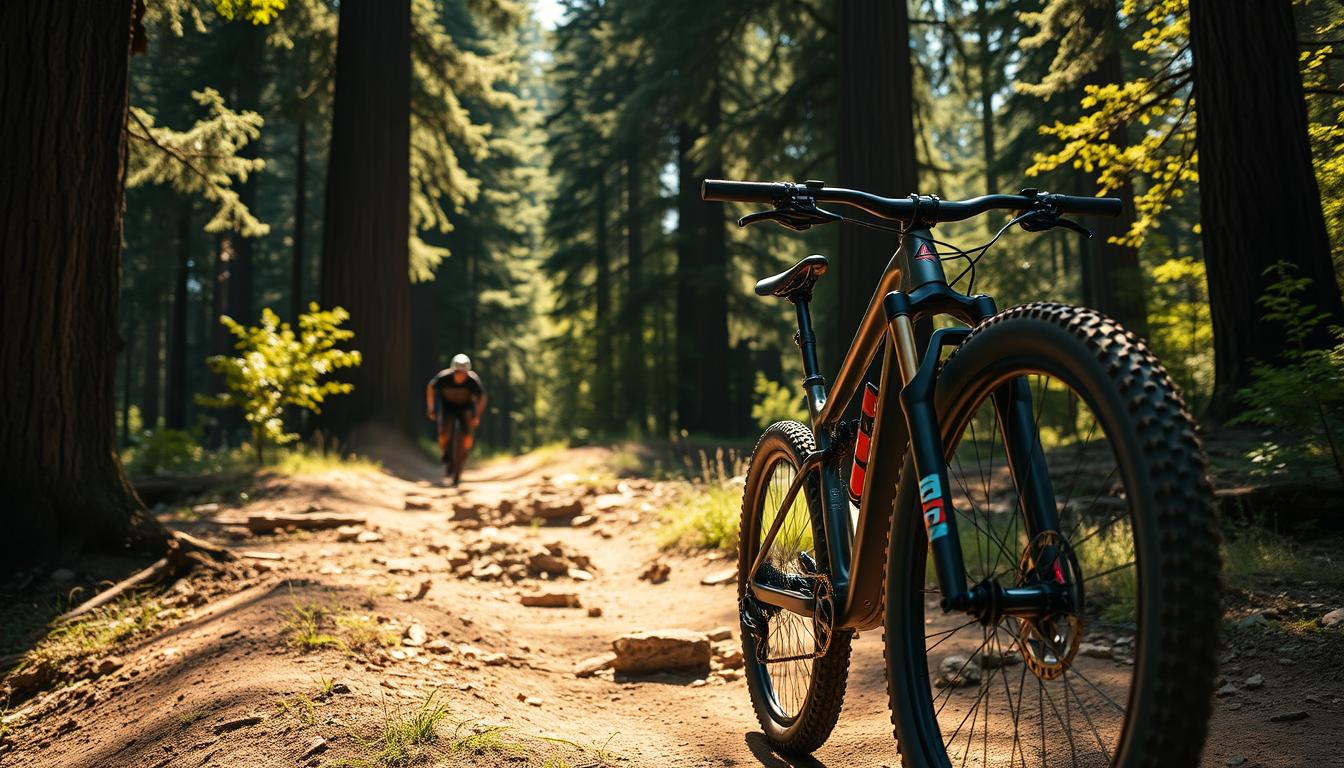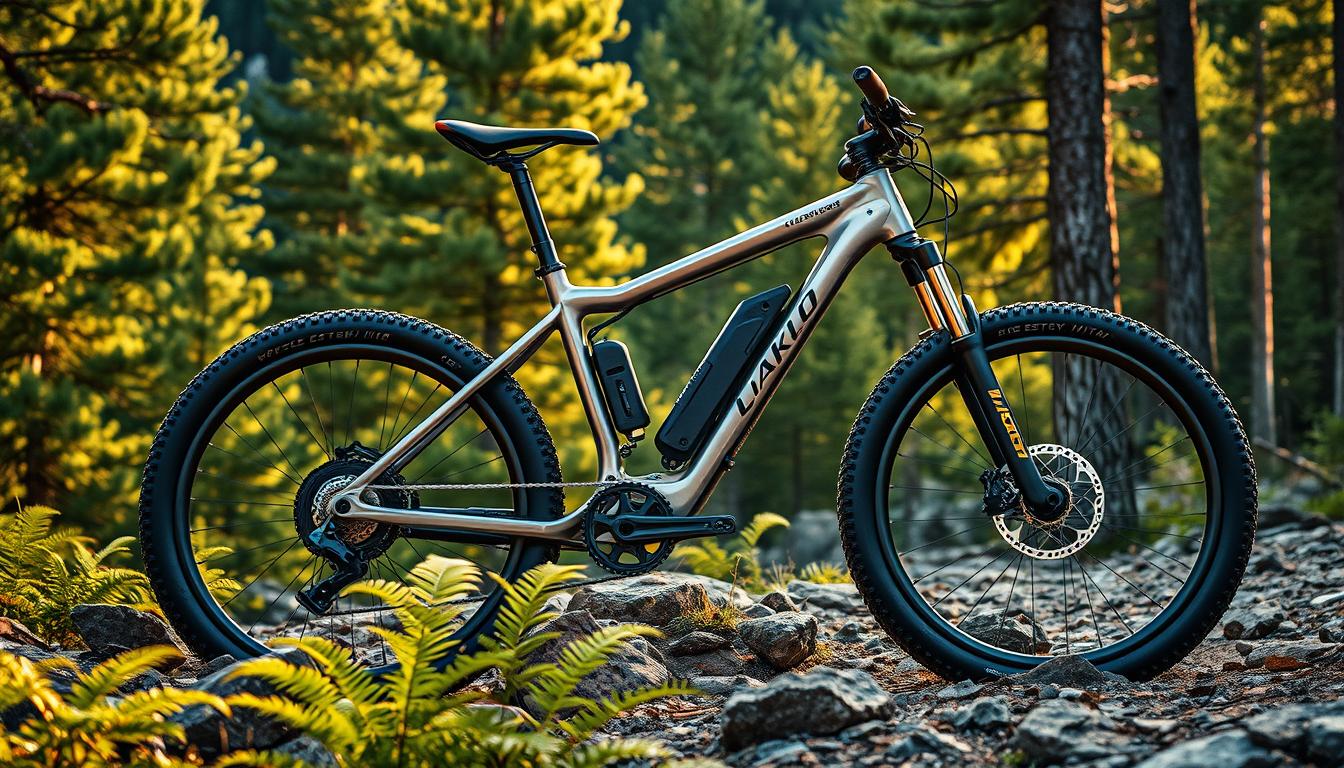Downhill mountain biking isn’t just a sport. It’s breath-taking, like the Formula One of biking. It started in the 1970s in California. Riders face tough paths with jumps, drops, and tricky rock gardens. This makes downhill biking a must-try for thrill-seekers.
A DH mountain bike stands out with its sturdy frame, top-notch suspension, and strong brakes. Since downhill races don’t have uphill parts, bikers can just zoom down. Plus, learning from experienced riders boosts everyone’s skills. It makes racing down slopes an unforgettable rush.
Downhill races are gaining fans worldwide, with events on special tracks. The races are nail-biting, often won by mere seconds. For those who love fast descents and tricky paths, knowing these bike features is key.
Introduction to Downhill Mountain Biking
Downhill mountain biking is thrilling, perfect for speed lovers. It’s about moving fast down steep and rough paths. Each ride down is unique, often taking three to five minutes, where speed matters most.
The history of this sport dates to the 1970s. Since then, it has become more popular. Cyclists show off their skills on downhill tracks at events like the UCI MTB Downhill World Cup.
Bike parks now have special trails for this sport. They welcome riders of all skill levels. Riders use strong bikes made for fast downhill rides. These bikes have good suspension and brakes.
Unique Design Features of a DH Mountain Bike
Downhill bikes have special features that boost performance and safety on steep slopes. Important aspects include materials, frame shape, and systems for stability and control. Knowing about these helps riders choose the best bike for them.
Frame Materials and Geometry
Downhill bikes use materials like aluminium and carbon fibre to balance strength and lightness. Many are under 30 lb (13.6 kg). Their design, with slacker head angles around 62 degrees, makes handling better at high speeds. Some bikes let riders adjust the head tube angle for their riding style.
Suspension Systems
These bikes have 7 to 10 inches (178 to 254 mm) of suspension travel to soften the impact of rough ground. A matching 7 to 8-inch (178 to 203 mm) suspension fork helps absorb shocks. This setup gives riders the confidence for tough downhill paths.
Braking Systems
DH bikes have advanced brakes for safety and control. They usually come with big brake discs and hydraulic quad piston disc brakes for powerful stopping. This is key for handling high speeds and making quick stops on steep hills.
Comparison with Other Mountain Bike Disciplines
Let’s explore how enduro and downhill mountain biking compare. Each discipline has its unique traits. Although both rely on racing down slopes, their race formats aren’t the same.
Enduro vs Downhill Mountain Biking
In enduro races, riders face several timed stages along with untimed uphill pedalling sections. This setup tests their stamina and skill across varied terrains. Downhill races, however, focus on a single fast descent. It challenges riders to tackle difficult tracks quickly, needing bravery and precision.
Rider Focus and Course Structure
Downhill competitors aim to zoom down as swiftly as possible. They train hard to conquer steep and tricky paths. Enduro cyclists have to be quick downhill but also need the strength for uphills. Mountain bike tracks can greatly differ. For instance, cross-country routes are 1.5-3km, while downhill paths prioritise speed and skill.
The Essential Components of a DH Mountain Bike
Building the ideal downhill bike requires considering key parts that shape performance and ride feel. Each component, from tyres to gears, is crucial in making the ride better on tough terrains.
Tyres and Wheels
Downhill biking tyres are made to face the challenges of steep downhills. Their broad designs boost grip, aiding stability during sharp corners and on rough paths. While some riders choose 29″ wheels for better movement over obstacles, others prefer smaller sizes for more control during quick downhills. The tyre choice impacts how well the bike handles different grounds. Using high-quality rims adds to the bike’s durability and its ability to perform on uneven terrains.
Drivetrain and Gearing
The drivetrain plays a big role in a DH bike’s performance on steep and rapid trails. Downhill bikes’ gears are built for strong downhill runs, unlike bikes made for uphill rides. They have sturdy cassettes and cranksets, with brands like KMC offering durable chains for tough rides. It’s best to pick parts that fit your riding style and comfort, weighing up the importance of lighter weight against performance. For riders focusing on technical descents, high-quality gears are a good investment.
To learn more about downhill biking gear, checking out expert advice, like bike gear essentials, or tips for new riders is helpful. Choosing the right tyres, wheels, and drivetrain parts significantly improves the ride, making every downhill run thrilling and safe.
Protective Gear for DH Mountain Biking
Safety in downhill biking starts with choosing the right equipment. Riders need to focus on their safety by picking quality gear. This includes helmets, eyewear, kneepads, and other essential items for mountain biking.
Helmets and Eyewear
For downhill riders, full-face helmets are crucial. They provide excellent protection for the head. These helmets are now lighter and offer better air flow while still being tough. Goggles are important too, preventing mud and debris from getting in your eyes. The best eyewear gives you a clear view and has lenses that you can swap depending on the weather. This helps riders keep an eye on the path ahead.
Kneepads and Additional Protective Equipment
Kneepads are important for mountain biking protection. They come in many styles and prices. For instance, the Leatt Knee Guard ReaFlex Pro costs about £99.99. But, you can find cheaper options like the 7iDP Transition Kids Knee Guards for £29.99. Don’t forget elbow guards, like the Fox Enduro Elbow Guard for around £84.95. Investing in good protective gear reduces injuries and builds confidence on rough trails.
Conclusion
DH mountain biking is a thrilling mix of speed, skill, and adventure on the mountain. The bikes are specially made to tackle very steep slopes. They have advanced tech for top performance. The design focuses on making sure riders stay stable and in control.
Races test the riders’ skills and bravery on tough tracks. These runs are short but full of adrenaline, lasting from 30 seconds to a minute. This excitement is what attracts many to DH biking. Plus, there’s a great community supporting all riders.
Downhill mountain biking offers fun rides and strong friendships. It’s packed with special thrills and challenges. That’s why cyclists all over love this sport.
FAQ
What are the key features of a DH mountain bike?
DH mountain bikes have tough frames to last longer. They have advanced suspension to absorb shocks and strong brakes for control on steep hills. These bikes are stable and responsive, perfect for riding on difficult terrains.
How did downhill mountain biking originate?
Downhill mountain biking started in the 1970s in California. It grew from a hobby to a competitive sport. Now, it’s popular worldwide with many races and special tracks for this thrilling sport.
What is the difference between enduro and downhill mountain biking?
Enduro and downhill mountain biking are different in how races are structured. Enduro includes several timed uphill and downhill stages. Downhill races are just fast descents from high points, focusing on getting the quickest time on a single run.
Why are tyres important on downhill bikes?
On downhill bikes, tyres play a big part. They handle extreme conditions on DH trails. Bigger tyres improve grip and stability, which are key for sharp turns and rough paths. Some riders choose 29″ wheels for smoother rides, while others go for smaller wheels for better agility.
What safety gear is recommended for downhill mountain biking?
Wearing the right safety gear in downhill mountain biking is crucial. Full-face helmets are a must in competitions for the best head protection. Goggles protect eyes from dirt. Kneepads and body armour also help avoid injuries during falls.
How do uphill transports work for downhill mountain biking?
For uphill transport, ski lifts take riders up to start downhill runs. This means riders save their energy for the descent. It makes racing more enjoyable.
Are there opportunities for novice riders in downhill mountain biking?
Yes, novice riders can find their place in local mini DH races. These events are a great way for beginners to join the downhill biking scene. They help new riders improve their skills and gain confidence on downhill courses.
